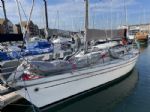












Boats for sale
| Laser 28 - Excellent example of this great design Hamble le rice |
 |
| Rossiter Pintail Mortagne sur Gironde, near Bordeaux |
 |
List classes of boat for sale |
Debunking Dodgy Sailing Theories |
Post Reply 
|
Page <1 45678 9> |
| Author | |||
Menace 
Far too distracted from work 
Joined: 16 Oct 10 Online Status: Offline Posts: 296 |
 Post Options Post Options
 Quote Quote  Reply Reply
 Topic: Debunking Dodgy Sailing Theories Topic: Debunking Dodgy Sailing TheoriesPosted: 08 Nov 11 at 6:06pm |
||
On the sail thing, slightly more shape provides higher lift, doesn't really matter the boat or cut of sail. Light winds, from an aero point, looking for max lift, flattening sails reduces drag but your lift falls off significantly too. Have a little giggle when I see some of the skiff guys, with one default outhall setting, tight or tight...
|
|||
 |
|||
craiggo 
Really should get out more 

Joined: 01 Apr 04 Location: United Kingdom Online Status: Offline Posts: 1810 |
 Post Options Post Options
 Quote Quote  Reply Reply
 Posted: 08 Nov 11 at 8:27pm Posted: 08 Nov 11 at 8:27pm |
||
|
Depending on sail cut, the outhaul has differing effects. On most sails it can only be used to control the draught of the lower 1/3 of the sail. The amount of travel needed on a skiff outhaul is small as generally the rig is pretty powerful and controlling the top and middle sections with cunningham and kicker is more critical.
In general though for light wind sailing it is essential to keep the flow attached to the sail, and too much draught can lead to the flow running out of energy leading to seperation. A tight outhaul while sailing a little free-er will ensure minimum drag but max forward drive. |
|||
 |
|||
Oatsandbeans 
Far too distracted from work 
Joined: 19 Sep 05 Location: United Kingdom Online Status: Offline Posts: 382 |
 Post Options Post Options
 Quote Quote  Reply Reply
 Posted: 08 Nov 11 at 9:47pm Posted: 08 Nov 11 at 9:47pm |
||
|
I agree that lots of sailors bang the outhaul on tight in most conditions ( and really tight when its windy), and its not fast. Obviously in a drifter you can have it out tight, but as soon as there is a bit of "weight" in the wind and all the tell tales are flowing, you can afford to put some depth in the base of the main. As long as you don't overdo this and make it too deep ( very slow!) it will give you a really good profile to the lower leach of the main ( return at the bottom batten) which can be used to give you great pointing ability. This will work up to max power conditions when you will then have to flatten things off again.
|
|||
 |
|||
Rupert 
Really should get out more 
Joined: 11 Aug 04 Location: Whitefriars sc Online Status: Offline Posts: 8956 |
 Post Options Post Options
 Quote Quote  Reply Reply
 Posted: 08 Nov 11 at 11:19pm Posted: 08 Nov 11 at 11:19pm |
||
|
Why have it out tight in a drifter? I've been winning in no wind for as long as I can remember (wish I could do so in breeze) with a fairly full sail. All very well having attached flow, but with no drive and a board flat sail that is impossible to read the windshifts with, you'll be going in the wrong direction, slowly. Let the sail breathe. I'm always amazed at seeing creases in the foot of a sail in those conditions.
|
|||
|
Firefly 2324, Puffin 229, Minisail 3446 Mirror 70686
|
|||
 |
|||
JohnW 
Really should get out more 
Joined: 17 Jul 07 Location: United Kingdom Online Status: Offline Posts: 552 |
 Post Options Post Options
 Quote Quote  Reply Reply
 Posted: 08 Nov 11 at 11:40pm Posted: 08 Nov 11 at 11:40pm |
||
I have very full fat sails, and find that the leech is hooked without any out-haul on in the lighter stuff. Pulling the out-haul on opens up the leech and my sails work better for me. Mike McNamara (who I believe knows a thing or two about sails and certainly way more than me) is an advocate of this. His tuning guides suggest outhaul fully on in all wind conditions up wind, only let it off on the reaches. |
|||
 |
|||
Menace 
Far too distracted from work 
Joined: 16 Oct 10 Online Status: Offline Posts: 296 |
 Post Options Post Options
 Quote Quote  Reply Reply
 Posted: 09 Nov 11 at 8:27pm Posted: 09 Nov 11 at 8:27pm |
||
I am 100 percent with you on this one Rupert! A lot of research work NACA have done on foils sort of supports that, foils with a little bit more chamber operate better at lower flow speeds and provide maximum lift, doesn't really matter if you're on a 49er or a firefly, the basic principals apply.
Not going to bang on about it, as I'm not that fussed about giving away what can make me sail faster. I'd prefer the people I race against to gaze at a gybing board, or a specifc fancy boat polish and think that's quick over a fundamental thing like getting sail dynamics or quick gybes right if they want.
|
|||
 |
|||
craiggo 
Really should get out more 

Joined: 01 Apr 04 Location: United Kingdom Online Status: Offline Posts: 1810 |
 Post Options Post Options
 Quote Quote  Reply Reply
 Posted: 09 Nov 11 at 8:44pm Posted: 09 Nov 11 at 8:44pm |
||
|
Menace,
You aren't wrong regarding the NACA studies, but remember NACA studies were performed in wind tunnels with solid wooden models, not soft sails. On a solid aerofoil the boundary layer flow may seperate but will ultimately continue flowing around the section enabling re-attachment. Outside of the boundary layer the flow may stay laminar and perform reasonably well. With a soft sail seperation leads also to loss of shape, which in turn makes re-attachment difficult. A tight foot will minimise the likelyhood of seperations but will limit the ultimate rig forces. Sailing free-er gets you back some of the lost drive. As you alude to, if you can keep flow attached over a deep section then it will be quicker, but in zephyr conditions this takes very careful and sensitive trimming and most people won't be able to keep it going. If you can then well done. |
|||
 |
|||
fudheid 
Far too distracted from work 

Joined: 21 Apr 11 Location: 51.53 N 01.28 E Online Status: Offline Posts: 241 |
 Post Options Post Options
 Quote Quote  Reply Reply
 Posted: 10 Nov 11 at 10:48am Posted: 10 Nov 11 at 10:48am |
||
 I think the critical thing here is 'tight' i don't think the suggestion is to have the outhaul bar tight like you would to flatten the sail in high/strong winds. But to flatten the camber slightly so flow stays attached, if your maximum camber is when you are fully powered up on a laser this used to be measured off the mid boom point say 6" (15cm) as you get to drifting conditions this comes tighter say around 2-3"(5-7.5cm). So the point is not to wind it on like a gorilla but to tune your sail to keep flow attached. |
|||
|
Cheers you
only me from over the sea...... |
|||
 |
|||
RS400atC 
Really should get out more 
Joined: 04 Dec 08 Online Status: Offline Posts: 3011 |
 Post Options Post Options
 Quote Quote  Reply Reply
 Posted: 10 Nov 11 at 7:04pm Posted: 10 Nov 11 at 7:04pm |
||
|
In a light wind which is not steady, the apparent wind can be a long way forwards in the lulls. A fairly flat main helps avoid or limit backwinding when this happens.
Sails and rigs vary. If you are sailing a boat where you ease the sheet a lot in light stuff to get more twist, the main can get very full on some boats unless the outhaul is pulled on reasonably, because the lack of mast bend will make the sail fuller than on a beat in F3. It may help to try to talk about % camber rather than how far the clew is pulled out. A two-boat drag race helps work out what works in a particular boat. Also, what some people call 'light' others are thinking, 'let's postpone until the wind arrives'. I'm thinking about those days when we struggle to make progress at all against the tide. |
|||
 |
|||
Menace 
Far too distracted from work 
Joined: 16 Oct 10 Online Status: Offline Posts: 296 |
 Post Options Post Options
 Quote Quote  Reply Reply
 Posted: 10 Nov 11 at 7:42pm Posted: 10 Nov 11 at 7:42pm |
||
You've just opened another massive can of worms there - light winds unsteady? Do you mean wind strength, direction, heated air, cooled air, on the sea, on a lake, etc. Sorry if I'm being a bit facetious, but there is a lot more to it in my opinion than simply saying flat sails are fast in light winds due to them being unsteady. There is good argument for if you can't adjust quick enough, it's more of a penalty to adjust wrongly in unsteady winds. One of the major plus points of automatic rigs in my opinion.
I'm going to stay firmly in Rupert's camp on this one. I don't think either of us are on about having bellowing sails, just a little bit more shape. I find it quicker on my boat, may be the way I sail though.
For what it's worth, Bethwaite supports flatter sails are fast in light winds, but sort of aludes to the fuller sail theory, don't think he notices he does it though. I'd have the same argument with him. The tell for me was when a good friend of mine asked me how I sailed in light winds. Think he was looking for a bite as he teaches sail dynamics and I walked straight into it. I argued the point about flat sails being fast on skiffs due to reduced drag and then he came back at me with all the NACA stuff and foil theory. I begrudgingly tried it in a drifter and it worked. Edited by Menace - 10 Nov 11 at 7:43pm |
|||
 |
|||
Post Reply 
|
Page <1 45678 9> |
| Forum Jump | Forum Permissions  You cannot post new topics in this forum You cannot reply to topics in this forum You cannot delete your posts in this forum You cannot edit your posts in this forum You cannot create polls in this forum You cannot vote in polls in this forum |
Bulletin Board Software by Web Wiz Forums® version 9.665y
Copyright ©2001-2010 Web Wiz
Change your personal settings, or read our privacy policy
Copyright ©2001-2010 Web Wiz
Change your personal settings, or read our privacy policy











 Printable Version
Printable Version Delicious
Delicious Digg
Digg Facebook
Facebook Furl
Furl Google
Google MySpace
MySpace Newsvine
Newsvine reddit
reddit StumbleUpon
StumbleUpon Twitter
Twitter Windows Live
Windows Live Yahoo Bookmarks
Yahoo Bookmarks Topic Options
Topic Options